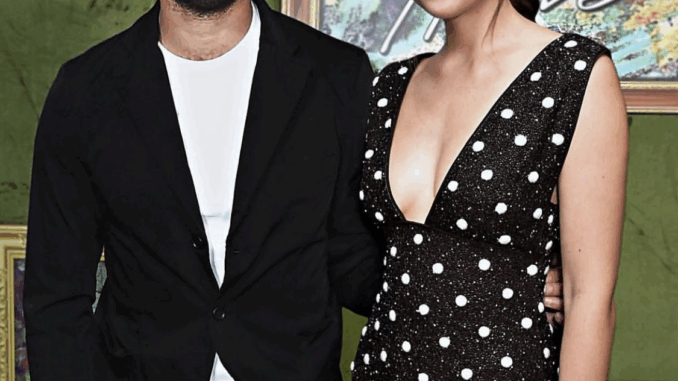
When Dakota Johnson first stepped onto the set of Fifty Shades of Grey, she wasn’t yet the name that would dominate Hollywood red carpets. Sure, she had acting roots—her mother, Melanie Griffith, and father, Don Johnson, were industry veterans. But being born into a famous family doesn’t guarantee a career; it certainly doesn’t guarantee becoming a cultural phenomenon. Fifty Shades changed all of that, almost overnight.
Before the role of Anastasia Steele, Dakota was still hovering in the periphery of Hollywood’s spotlight. She’d appeared in a few supporting roles, some indie films, and had a brief but memorable scene in The Social Network. But nothing screamed “leading lady” yet. Then came the call that would shift her entire trajectory: an audition for the most talked-about book adaptation in years—E. L. James’s explosive erotic trilogy.
It was a gamble. Taking on the lead in Fifty Shades wasn’t just about memorizing lines and delivering emotional depth—it meant baring yourself, physically and emotionally, for the world to scrutinize. It meant stepping into a role that would blur the line between character and actor, fantasy and reality. Many actresses reportedly turned it down, fearing the stigma or the career damage. Dakota said yes.
And then the world said her name.
The moment Universal announced Dakota as Anastasia, the internet erupted. Some cheered. Others doubted. Could she pull off the naive yet strong-willed young woman opposite the enigmatic Christian Grey? Could she survive the fan scrutiny and the inevitable media frenzy?
When Fifty Shades of Grey premiered in 2015, the answers came fast. The film shattered box office records despite mixed (and often brutal) reviews from critics. And while Jamie Dornan’s portrayal of Christian Grey received its share of attention, it was Dakota’s performance that stole the conversation. She wasn’t just a passive participant in the spectacle—she carried the emotional weight, grounding the erotic whirlwind with vulnerability, humor, and a quiet defiance that made Anastasia more than just a fantasy figure.
Behind the scenes, Dakota’s work ethic impressed the crew. She reportedly approached every intimate scene with meticulous preparation—not just for the choreography, but for the emotional beats. She insisted on finding the humanity in moments that could have easily slipped into caricature. That effort paid off. Even critics who disliked the film often praised Dakota for elevating the material.
But fame is never simple. Almost as quickly as she was celebrated, she was typecast in the public eye. For a while, it seemed that no interview, no press appearance, could escape questions about nudity, sex scenes, or her chemistry with Jamie Dornan. Dakota handled it with a mix of wit and composure, often disarming interviewers with sharp humor. One of her most viral moments came when a reporter asked if she was worried about her parents seeing the movie—Dakota deadpanned, “They know I’m not a virgin.” The clip exploded online, solidifying her image as charmingly unflappable.
The sequels, Fifty Shades Darker and Fifty Shades Freed, cemented her star power. By the final installment, Dakota wasn’t just the girl from the “naughty movie”—she was a bankable leading lady. Her face graced magazine covers, fashion houses sought her out, and directors began offering her roles far outside the erotic-romance genre.

Ironically, some of the very critics who once dismissed Fifty Shades later admitted Dakota’s career choices post-franchise proved her versatility. She moved seamlessly into indie dramas like Suspiria and The Lost Daughter, as well as quirky comedies and festival darlings. She refused to be boxed in by Anastasia Steele, even as she acknowledged that without that role, none of it might have happened.
Dakota herself has been candid about the film’s impact. In interviews, she’s admitted that Fifty Shades was both a blessing and a strange, surreal experience. “I’m proud of it,” she’s said, “but it was crazy. It’s not like making any other movie.” That mix of gratitude and disbelief is telling—she knows the franchise was a cultural lightning rod, but she also recognizes it gave her the platform to choose her own path.
And yet, the conversation about Fifty Shades never fully disappears. Whether she’s promoting a new film or walking a red carpet, Anastasia Steele is the shadow trailing behind her. For some stars, that might feel like a burden. Dakota seems to wear it like a badge—one that says, “Yes, I did that. And I can do anything else, too.”
The truth is, Dakota Johnson’s fame isn’t just because of Fifty Shades—it’s because of how she handled Fifty Shades. Many actors have starred in controversial blockbusters; few have emerged with their dignity, humor, and career momentum intact. She did. And that’s why, a decade later, she’s not just remembered for the role—she’s remembered for owning it.
